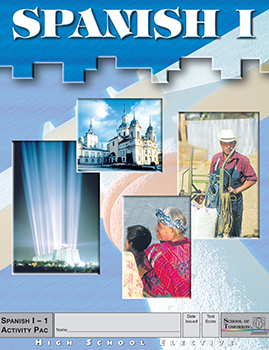ACE’s Spanish 1 course is very practical for students working independently. It consists of 25 videos, twelve Activity Pacs, and four scoring keys. The course is very affordable because you purchase only the Activity Pacs and scoring keys. The videos are provided free online.
Two fluent Spanish speakers teach the lessons on the videos. Unlike most ACE video courses, this one is absolutely dependent on the video presentations—primary instruction comes from the videos with practice and reinforcement activities found in the Activity Pacs. The 24 instructional videos each run about an hour and a half, covering a number of lessons in each one—more than 36 hours of video in all. The 25th video is for testing, and it is not readily available online—you need to email
The videos were originally created for VHS technology. There’s even a mention about the bother of rewinding the tape to find where the student left off from their last lesson. While the videos were high-tech when they were originally created, they are a little dated now. Even so, they are still very effective and fairly easy for students to use.
There are two primary teachers for the course, but they sometimes bring in additional presenters. It’s not a talking-heads-style course. The videos use graphics, images, and maps. As they teach, the presenters leave time for students to practice responding, and they frequently tell the student to stop the video and complete pages in their Activity Pacs.
The course combines both conversational and grammatical approaches so that students are quickly able to use short Spanish phrases yet develop a long-term understanding of how the language functions.
Like most Spanish 1 courses, this course covers typical topics like food, relationships, clothing, calendar terms, numbers, etc. Geographical and cultural information on Spanish-speaking countries, Bible verses, biblical proverbs, and wisdom principles are scattered throughout the course. Christian “witnessing” vocabulary is also addressed in one lesson.
The presentation is a well-balanced mix of vocabulary, written work, translation practice, listening, reading, and other activities, although all of these are not used in every lesson.
Ideally, students should be compiling notes of their own as they go through the course, but I expect most will not. Even if they do, a Spanish/English dictionary and a grammar handbook with grammatical summaries and conjugation charts will be extremely helpful for quick reference.
If the videos are used as directed, students will hear and speak so much Spanish that it should greatly enhance their comprehension and pronunciation skills. Careful attention to pronunciation, common and uncommon usage, geographical variations, and other such details put this course a cut above many others.
Although only Spanish 1 is available from ACE, students should easily be able to follow with almost any Spanish 2 course.








